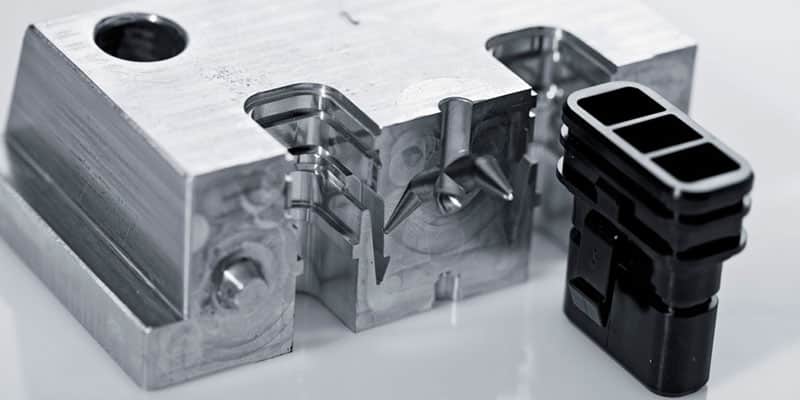Though injection molding is largely recognized as the most cost-efficient technique for mass-producing parts or products, there is one area in the process that still causes major headaches for manufacturers: tooling and mold making. Thanks to manufacturing innovations, however, Rapid Tooling is gaining in momentum and enabling businesses to decrease turnaround times for product development and, ultimately, time-to-market.
What is Rapid Tooling?
Rapid tooling, also known as RT, is an approach in which rapid prototyping processes, such as 3D Printing, are used to speed up more traditional tooling and molding methods for prototyping or limited volume production.
The Rapid Tooling approach consists of transforming CAD models into physical tools or molds using rapid production methods, drastically reducing development cycles for products. The 3D printed or machined molds—though not well suited for large volume production—allow manufacturers to test and evaluate the design and quality of a tool before ramping up into full-scale production.
There are two main Rapid Tooling techniques employed: direct and indirect.
In direct Rapid Tooling, rapid prototyping processes are used to manufacture the actual core and cavity mold inserts. This approach is particularly useful for creating tools that are geometrically complex.
Indirect rapid tooling, on the other hand, uses rapid prototyping processes to create a master pattern, which is then used to produce a tool using soft tooling (primarily for plastic production) or sacrificial models (primarily for metal investment casting).
How 3D printing is enabling rapid tooling?
3D printing, or additive manufacturing, is a key process for enabling Rapid Tooling. Various 3D printing methods, including fused deposition modeling (FDM), stereolithography (SLA), selective laser sintering (SLS), and binder jetting, can be used to produce master patterns for soft tooling or direct tools and molds.
In various industries, 3D printing is increasingly being used to produce jigs, fixtures, and tools that can speed up the production process and reduce costs significantly. The technology, which builds parts layer by layer using a range of polymer or metal materials, can cost-effectively produce one-off pieces on demand. Additive manufacturing also creates unique opportunities for complex geometries, which are impossible to achieve using traditional manufacturing processes.
By leveraging 3D printing for Rapid Tooling applications, manufacturers can benefit from functional mold prototypes, which can be tested and evaluated for quality and performance. 3D printed tools can also be used to fulfill small series production runs or customized, one-off parts. In the jewelry industry, for instance, 3D printed wax models can be cast with precious metals to create intricate and finely detailed pieces. In the automotive sector, 3D printed tools are increasingly being used to streamline production and cut costs for prototyping.
For large volume production, once a 3D printed prototype mold has been tested and verified, more conventional tooling practices, such as CNC Machining, can be employed to produce industrial-grade tooling. In these cases, additive manufacturing allows for the tool design to be tested and optimized before investing in an industrial tool.
Benefits of Rapid Tooling
- Cost
In the injection molding process, the high cost of tooling is amortized through mass production. In other words, because the cost of the mold is often the largest investment and the subsequent injection molding is low-cost, the more parts produced using a single mold, the lower the cost-per-part. For prototyping or small batch production, however, traditional mold making techniques cannot be financially justified.
Rapid Tooling has a huge cost advantage for manufacturers compared to conventional tools, with savings of up to 95%. These dramatically lower costs enable manufacturers to prototype tools and molds and tweak and refine designs with more flexibility. The cost also makes tooling more accessible in many cases, for manufacturers with tighter budgets.
- Faster time-to-market
Tied to the cost-benefit of Rapid Tooling is the speed at which tools can be produced. Though conventional tooling processes can take months to deliver, Rapid Tooling can shorten lead times to weeks or even days.
These rapid turnaround times early in the product development process help to speed up the overall time-to-market for businesses and enable more flexible production.
- Product optimization
The third benefit of Rapid Tooling has to do with product development itself. While the cost and length of conventional tooling processes limit the iterations of a given part, Rapid Tooling makes it possible to tweak and improve a mold’s design until a product has the desired properties and functions. Consequently, any design faults can be identified and addressed before production, saving additional time and costs down the line.
Unlike some Rapid Prototyping, Rapid Tooling also enables manufacturers to test and evaluate functional prototypes before moving into production. In other words, prototypes made via Rapid Tooling are not simply concept models, they can be evaluated in the same ways as the final product would.
Moreover, molds made using a Rapid Tooling approach can ultimately fulfill production series made up of thousands of parts.

